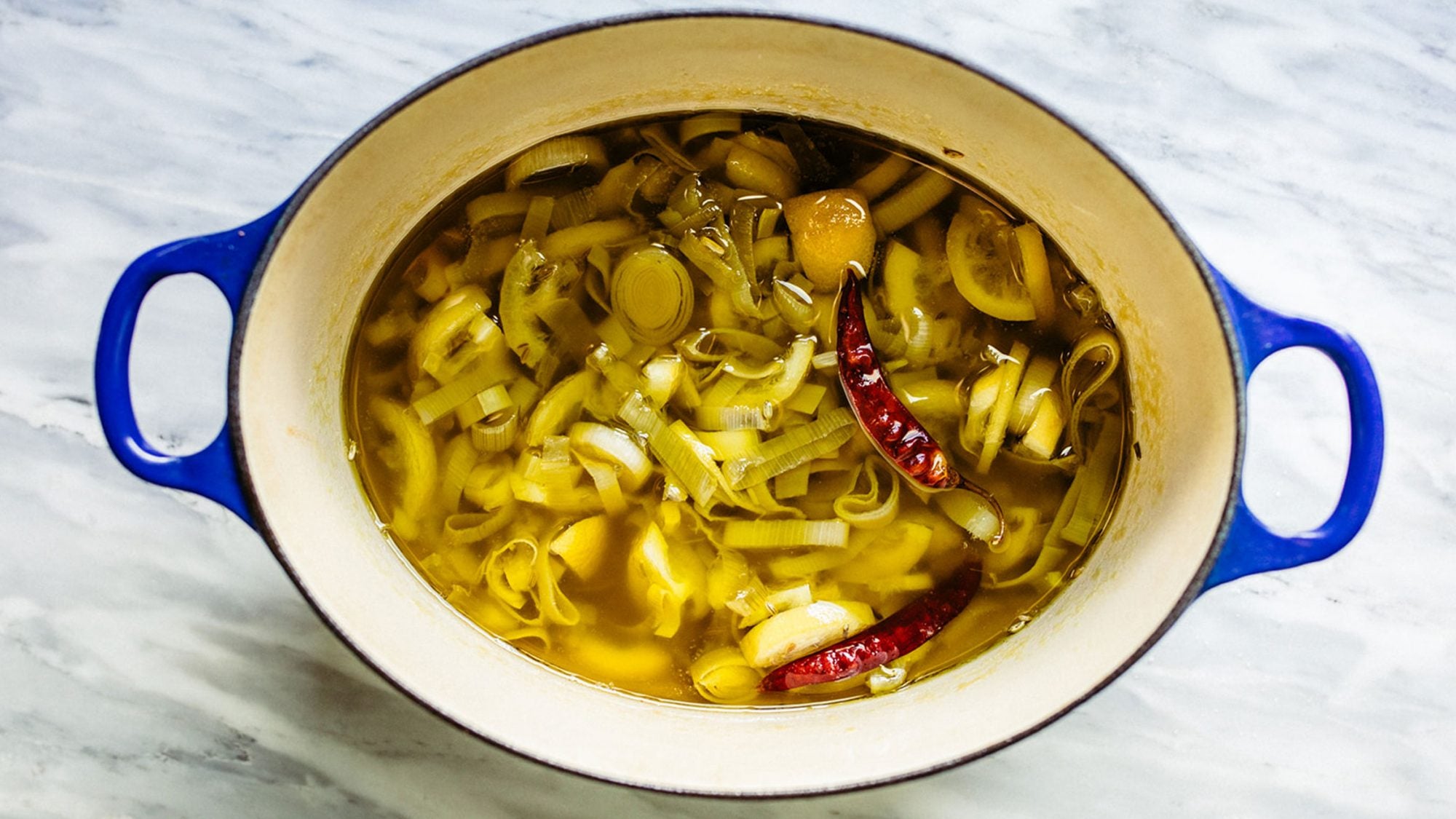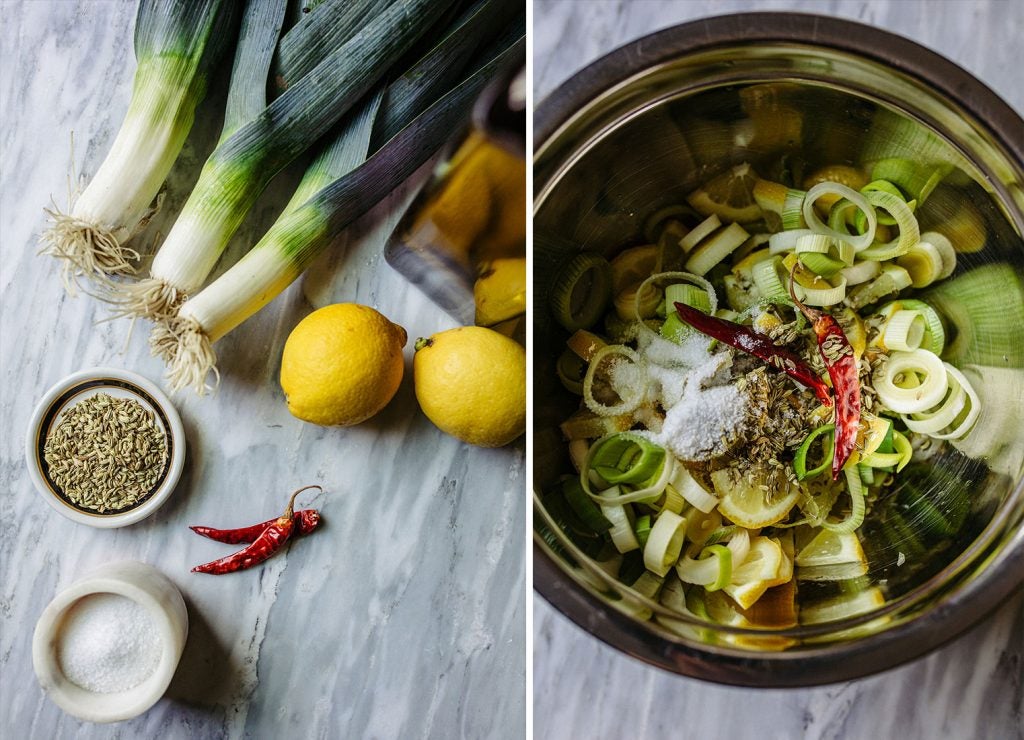
Give your thinly sliced leeks and lemons the low-and-slow treatment to spruce up your roast chickens, sandwich spreads, and dressings.
I’m going to take a big swing here: confit does to food sort of what a dip in a bubbling Jacuzzi does to me after a long day. It relaxes, but it also rejuvenates. Unlike a hot tub’s cauldron of chlorinated water, though, a confit involves a warm pot of fat, which transforms and delicately tenderizes its contents, whether that’s chicken thighs or a handful of spring alliums and thinly cut lemon slices.
Duck legs are probably the most iconic recipients of the confit treatment—and a bistro menu staple. The process of making them involves warming duck fat—and I mean just warming it, not even really bringing it to a simmer (and definitely not to a boil)—and then submerging duck legs in that warm fat. This Goldilocks duck fat temperature usually falls into a range from 170 to 250 degrees Fahrenheit. After bathing for a few hours on low, the meat transforms to a pleasurable, fall-off-the-bone-tender texture.
That pot full of fat regulates the temperature differently than, say, the dry air in an oven or the quietly bubbling chicken stock in a braise would. This type of cooking was historically a way to preserve meat by gradually drawing out the moisture, replacing it with fat, and then storing the meat in this fat to be reheated and served later.
As luxurious as a confited duck leg can be, most of the time, when I employ this technique in my kitchen, it’s as a way to turn vegetables into velvety sides (like whole tomatoes, eggplant, or fennel for glistening salads with peppery greens) or a powerful condiment, like the leeks and lemon recipe below.

Vegetables and alliums take much less time to cook than tougher, bone-in pieces of meat like a duck leg or even carnitas from pork shoulder, and the resulting infused olive oil can be employed as a sauce, a vinaigrette base, or even easily used again to confit a different vegetable. Think of the oil left over from gently cooking some cloves of garlic on the stovetop until they’re meltingly soft. Sure, the garlic itself is spreadable, sweet, and delicious—but the oil it was cooked in is just as useful in the kitchen.
The result is a potted condiment that’s jewel-like and fully relaxed, that uplifts almost anything you put it on.
This is why I love to cook delicate rings of leeks and thin triangles of lemons together in a bath of just-warm olive oil until everything is slightly softened and the flavors have melded together. It creates a really delicious oil I can use on anything, and it’s arguably way more versatile than the well-known garlic version. Leeks, like garlic, are alliums, but they have the complexity of tasting mildly like garlic and onion at the same time. Lemons, normally juiced or zested for bright acidic or floral flare, maintain those qualities even when confited.
The result is a potted condiment that’s jewel-like and fully relaxed, that uplifts almost anything you put it on. Eventually, the confit and oil will solidify in your fridge, and you might think storing it in multiple containers will make it easier to use, but I find that fussy. I just store the whole batch in one large container, spoon out the amount of confit I want at the time, and gently rewarm it in a pan before using it, allowing the flavors to dictate my cooking over the course of the week.
Say I’m just about to roast a whole chicken; I’ll spoon out a half cup of confit from the refrigerator before I start cooking, and this might be enough time for it to melt before I cut the roasted chicken into pieces. I’ll then toss those chicken pieces in a bowl with a few handfuls of arugula, some sort of cooked grain like farro, maybe a legume like big, creamy corona beans, and that now-room-temperature confit. The result is a salad that’s all-purpose and all flavor. Perhaps I’ve made steak and potatoes. This sweet and acidic condiment can be spooned over the sliced steak and those tots. If I wanted a whole baked potato, I’d slather a hefty amount of sour cream on it (like a normal person), but then I’d drizzle this confit over the top with some crumbles of bacon.
Want to add some character to a flat vegetable sandwich? Try saturating your bread with this confit before adding aged white cheddar, sliced avocado, and cucumbers. Or simply add a little white wine vinegar (or fresh lemon juice) to these leeks and lemons for a quick salad dressing. And when the leeks and lemons have been used up, and all that’s left in the jar is olive oil? Just drizzle it on some freshly steamed rice.